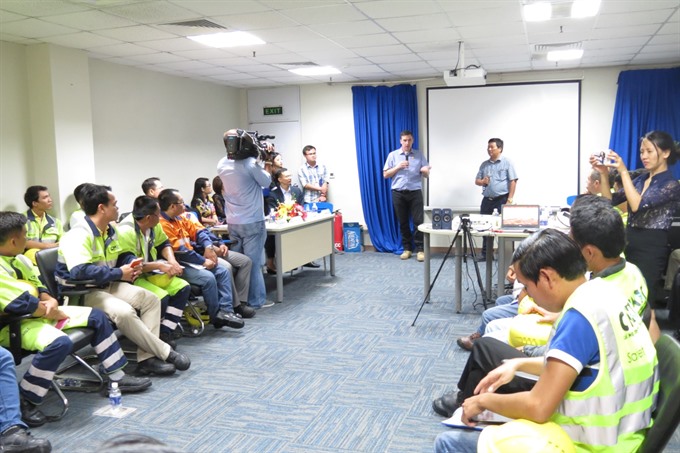 Society
Society

Last year, a couple was killed and their daughter injured after a truck hit their motorbike on Highway 51 in Bà Rịa-Vũng Tàu Province’s Tân Thành District, which has the highest rate of fatalities in the province.
 |
| Truck drivers at Cái Mép International Terminal take a training course to improve their driving skills and defensive driving techniques. The accident rate around the port cluster in Tân Thành District is unusually high. — Photo Courtesy of AIP Foundation |
Gia Lộc
HCM CITY — Last year, a couple was killed and their daughter injured after a truck hit their motorbike on Highway 51 in Bà Rịa-Vũng Tàu Province’s Tân Thành District, which has the highest rate of fatalities in the province.
In the first nine months of last year, the province had more than 570 traffic accidents, most of them on Highway 51, according to the provincial traffic police.
Though heavier traffic is cited as one cause, drivers’ lack of awareness of traffic regulations is considered to be the main reason for the increase in accidents, according to local authorities.
In recent years, the volume of traffic in the area has worsened because of the development of the Cái Mép-Thị Vải port cluster.
The port cluster is the only one in the country that can receive large container vessels travelling directly to Europe and the US without the need to transit through a third country.
Over the last five years, cargo volume through the port has risen 16 per cent annually, leading to far more vehicles travelling from the port cluster to other provinces and cities via 965 Road, which connects to Highway 51 and to roads leading to industrial parks near the cluster.
Every hour, more than 1,880 trucks and cars, in addition to 3,400 motorbikes and bicycles, travel on Highway 51.
Besides the heavy traffic, there are no electric signs that warn drivers to reduce speed at intersections on roads leading to Highway 51 near the port cluster and on streets near industrial parks.
Many traffic signs along these streets are hidden by trees, while streets under construction cannot accommodate the increasing number of vehicles.
Poor public awareness
Despite the growth in traffic, the provincial traffic police and Traffic Safety Committee said that most accidents in the district, including on Highway 51, were caused by drivers’ lack of awareness about traffic regulations.
Last year, the Asia Injury Prevention (AIP) Foundation filmed vehicles travelling on Highway 51 and 965 Road.
The films showed that drivers of motorbikes drove the wrong way, in the wrong lanes, and at high speed. Buses parked illegally to pick up passengers.
Moreover, truck drivers did not obey the proper right of way before they made a turn and did not make lane changes properly.
The AIP Foundation also surveyed 150 truck drivers about their knowledge, behaviour and driving practices.
Nearly 91 per cent of them did not clearly understand the regulation about keeping a safe distance from another vehicle while driving.
More than 86 per cent had inexact answers about how or when to make way for other vehicles, while at least 80 per cent did not closely observe the road while driving.
In addition, more than 60 per cent did not think that running stop signs was unsafe, and more than 79 per cent said that they drove without stopping for a period of more than four hours.
Đặng Văn Mạnh, a 32-year-old truck driver from Bà Rịa-Vũng Tàu Province, said that driving for many consecutive hours was common among truck drivers.
“In the past, I drove for 10 consecutive hours to deliver goods to meet the schedule,” Mạnh said.
Nguyễn Tiến Trung, a truck driver at the Cái Mép International Terminal, said that he had experience driving for many enterprises.
“Many young drivers do not have experience in solving problems in driving. Some of them do not even have a driving license because the companies can’t find drivers of a certain standard,” Trung said.
Newly recruited drivers should be provided training and drive with experienced drivers for at least one month, he said.
Trần Hữu Minh, deputy chief of the National Traffic Safety Committee, said the committee had given priority to more training to all drivers, in addition to upgrading transport infrastructure.
Last week, the country’s first road-safety training course for truck drivers was held at Cái Mép International Terminal to improve driving skills and defensive driving techniques of licensed drivers. The aim was to reduce traffic accidents in Tân Thành District.
A Master Trainer’s Guide is being developed along with the driver training course.
The course is a part of a road-safety programme called Lifting Safety, carried out by the National Traffic Safety Committee in co-operation with the AIP Foundation.
The programme is under the sponsorship of APM Terminal, an international terminal operator based in the Netherlands with facilities in 69 countries.
The programme includes targeted education and community engagement activities to enhance road-safety awareness among students and their parents, as well as truck drivers who use the Cái Mép International Terminal.
In 2017, many other training courses on road-safety skills will be provided to truck drivers in the Lifting Safety programme.
A media awareness campaign and community-based activities in and around the Cái Mép International Terminal port will also be organised.
Minh said that training in safe driving skills would be given to truck drivers at other ports in the country and drivers of other vehicles, including motorbikes.
“Like many of my fellow truck drivers, my family and I live close to the port,” Võ Tấn Lực, a driver at Cái Mép International Terminal, said.
“Improving my driving skills is going to help keep me, my wife, children and coworkers’ families safe in our community.” — VNS


.jpg)

